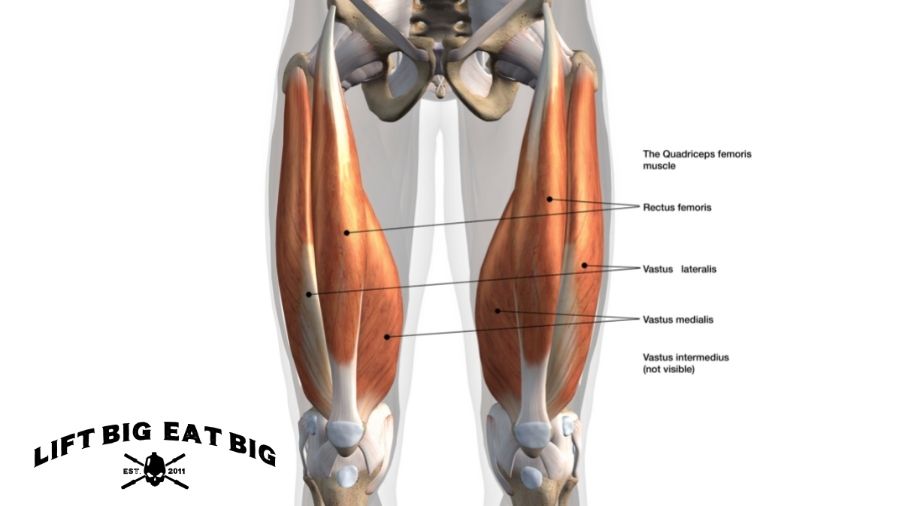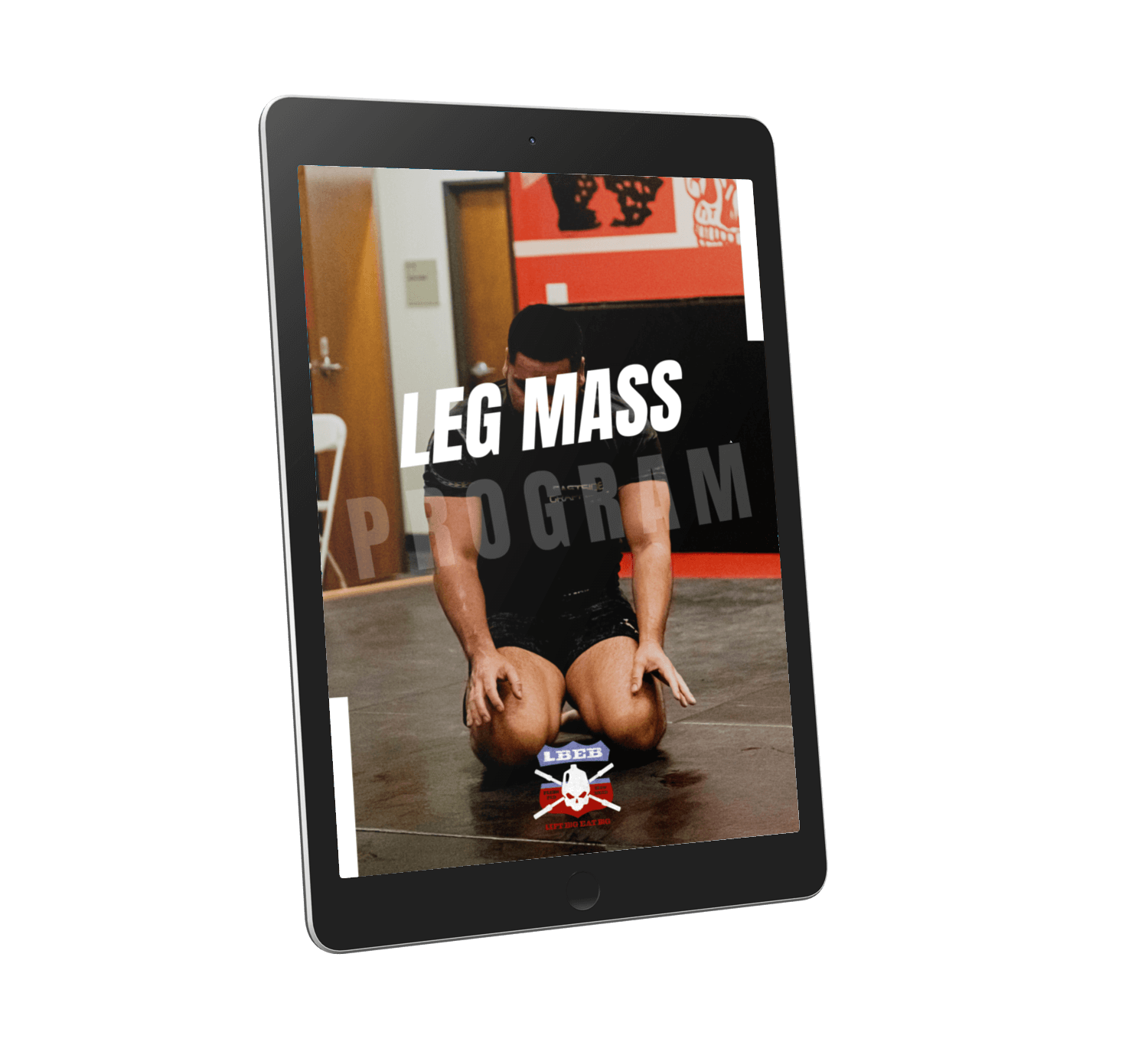If you're stuck at home or in a hotel room or no longer want to hit the gym, all is not lost when growing your quads. Your bodyweight is still an effective tool for building big quads if you're willing to push through the pain of ultra-high rep training.
So, I've detailed 14 of the best quad exercises you can do at home without equipment to build quads you can be proud of. But first, we need a little anatomy lesson to know which exercises target which part of the quads.
Table of Contents
Quadriceps Anatomy
The quadriceps are made of four main muscles:

The vasti muscles cross the knee joint and extend the knee while the rectus femoris muscle crosses the knee joint and the hip joint. Making the rectus femoris biarticular acting as a knee extensor and hip flexor.
Closed chain exercises like squats primarily target the vasti muscles. In contrast, open-chain exercises like leg extensions target the rectus femoris [1,2]. This is why it is vital to perform compound and isolation exercises to develop big quads.
14 Best Quad Exercises At Home With No Equipment
Heels Elevated Bodyweight Squat
During the pandemic lockdown, this was the go-to quad exercise for mass for myself and my wife at home when we had no equipment. The bodyweight squat isn't very challenging, but the burn is unreal when performing ultra-high reps.
You emphasize the quads further than squatting with flat feet by elevating the heels. The elevated heels allow for an upright torso and the knees to travel further forward, resulting in greater quad activation. Here's how to do it:
Hindu Squat
The Hindu squat is like a hybrid sissy squat (more on this exercise later) and bodyweight squat. As the name implies, it originates from India and its vast history in wrestling. You get a far greater quad emphasis than the heel elevated squat because you're squatting on your toes and pushing your knees forward. Here's how to do it:
Split Squat
The split squat is an excellent single-leg exercise when you don't have much space to move. When done with a moderate-length split stance, it will light up your quads. It's not a true single-leg exercise as the back leg contributes significantly. But this makes it more accessible for all levels of trainees. Here's how to do it:
Front & Rear Leg Elevated Split Squat

This is the split squat on steroids. Elevating both feet increases the range of motion and, therefore, the tension of the legs leading to a more significant muscle growth response. However, this increased range mainly stretches the glutes, so you'll find yourself very sore the following day.
That doesn't mean the quads don't get hammered. If you set up, so your knee travels forward when descending instead of maintaining a vertical shin, you'll get more quadriceps involvement. Here's how to do it:
Bulgarian Split Squat
If you want to reduce the involvement of the supporting leg, elevating it with the Bulgarian split squat is one way of doing this. You can place more bodyweight over the front leg increasing the force required to descend and ascend in the split squat. Here's how to do it:
Forward Lunge
People who suffer from knee pain may struggle with this lunge variation because of the sharp deceleration and pushing back with the front leg. However, if you don't have any niggling pain, the forward lunge is one of the best lunge variations for quads. Here's how to do it:
Lateral Lunge
The lateral lunge isn't a commonly used quad builder. But it provides variation and takes you out of the typical up and down, front to back movement. The lateral lunge isn't going to grow slabs of muscle on your legs. Still, I would highly recommend keeping this exercise in your weekly rotation.
Even if it's just part of your warm-up, you can lose the ability to lunge to the side quickly. Here's how to lateral lunge:
Reverse Lunge
The reverse lunge is an easier lunge variation if you have bad knees. I teach the reverse lunge as the first progression from the split squat because it is easier to master and feels better on the knee. Many people quote this is mainly a glute exercise. It does torch the glutes. However, your quads still contribute similarly to the exercise. Here’s how to do it:
Walking Lunge
I love the walking lunge because you can set a distance goal instead of reps. It makes ultra-high rep sets of walking lunges more bearable. Further, by taking shorter steps, letting the knee past the toes, and keeping an upright torso will place more stress on the quads. Here's how to do it:
Sissy Squat
The sissy squat is not for the faint-hearted. If you're a beginner, miss this exercise. If you have a solid strength base, start with very small ranges of motion. These have recently gained popularity but have been performed by various physical culturists for many years and is a mightily effective exercise for big quads.
It is one of the few bodyweight exercises that will target your rectus femoris since you’re performing a bodyweight leg extension. Here’s how to do it:
Pistol Squat
The pistol squat is the most advanced bodyweight quad exercise. You have no supporting leg placing all of your bodyweight on one leg. When squatting on two legs, the bodyweight above the hips equals 68% of your total bodyweight [3].
This increases to 84% being supported on one leg when on one leg. Interestingly, a bodyweight pistol squat is equal to performing a barbell back squat with your bodyweight on the bar. Safe to say, if you can pump multiple reps of pistol squats, your quads will grow! Here's how to pistol:
Reverse Nordic
While the reverse Nordic may not be a staple exercise for big quads, it is excellent for maintaining knee health. Further, you target the rectus femoris muscle eccentrically, which is epic for muscle growth [4]. Here’s how to do it:
Long Duration Isometric Split Squat
Isometrics for hypertrophy come and go in popularity depending on the current fitness fad. But they have been used for centuries (yes, centuries) by old-time strongmen and physical culturists to build massive physiques.
I wouldn't class the long-duration isometric split squat as an intense muscle builder per se. Still, the exercise makes the perfect warm-up before hammering your quads. Isometric exercise has a numbing effect on the tendons, so if you suffer from knee tendon pain, this will help you smash through your leg session at home [5]. Here’s how to do it:
Wall Sit
The wall sit is the regressed version of the isometric split squat. If you struggle with holding the split squat position, use the wall sit. While it's not as potent of a stimulus, it gets the job done. At the end of your workout, you can also use this to pool a ton of blood in your quads, creating a huge hypoxic (lack of oxygen) environment to signal muscle growth. Here's how to wall sit:
Best Quad Workout At Home With No Equipment
Exercise | Set/Rep |
|---|---|
A1) Long Duration Isometric Split Squat | 1 x 60 sec/leg |
B1) Heels Elevated Squat | 1 x 50-75 |
C1) Hindu Squat | 2 x 50 |
D1) Sissy Squat OR Reverse Nordic | 4 x 5-6 |
E1) Walking Lunge OR Split Squat | 1 x 50/leg |
How Can You Strengthen Your Quads At Home?
Strengthening your quads at home without equipment requires ultra-high rep training. It will burn and will take significant willpower to fight through these workouts. But this is what is necessary to challenge your quads into new growth.
Legs are the hardest body part to train at home without equipment and see significant growth. They support your bodyweight all day and are large, strong muscles that require substantial overload. This is why single-leg exercises are often preferred when training with no equipment at home.
However, you can still build big legs. It will just take mental fortitude to push through the pain when you’re on rep number 50!
Summary
These are the best quad exercises at home with no equipment that you can plug and play within your workout. As the legs are large, strong muscles, you'll need to perform much higher reps than you traditionally would within the gym when you have weights available.
With most of these exercises, you will need to get close to failure to maximize muscle growth. This will be the only way to increase mechanical tension and metabolic stress.
Grow Enormous Legs That Won’t Fit Your Jeans
A leg specialization program to bust through muscle growth plateaus and finally throw away those skinny jeans.
References
1. Zabaleta-Korta, A., Fernández-Peña, E., Torres-Unda, J., Garbisu-Hualde, A., & Santos-Concejero, J. (2021). The role of exercise selection in regional Muscle Hypertrophy: A randomized controlled trial.
2. Mangine, G. T., Redd, M. J., Gonzalez, A. M., Townsend, J. R., Wells, A. J., Jajtner, A. R., ... & Hoffman, J. R. (2018). Resistance training does not induce uniform adaptations to quadriceps. PLoS One, 13(8), e0198304.
3. Dempster, W. T. (1955). Space requirements of the seated operator, geometrical, kinematic, and mechanical aspects of the body with special reference to the limbs. Michigan State Univ East Lansing.
4. Douglas, J., Pearson, S., Ross, A., & McGuigan, M. (2017). Chronic adaptations to eccentric training: a systematic review. Sports Medicine, 47(5), 917-941.
5. Rio, E., Kidgell, D., Purdam, C., Gaida, J., Moseley, G. L., Pearce, A. J., & Cook, J. (2015). Isometric exercise induces analgesia and reduces inhibition in patellar tendinopathy. British journal of sports medicine, 49(19), 1277-1283.

